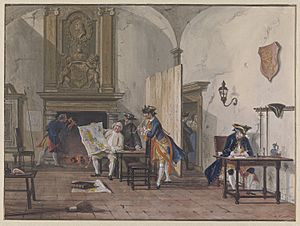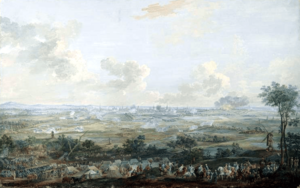Barrier Treaty facts for kids

Dutch officers in a guardroom while one holds a map of Flanders, by Cornelis Troost between 1730-1750
|
|
| Signed |
|
|---|---|
| Effective | 15 November 1715 |
| Condition | In order to help defend against French invasion, Dutch troops occupy fortresses within the Austrian Netherlands and share the costs with Austria. |
| Expiration | 1781 |
| Signatories | |
The Barrier Treaties were a set of agreements signed between 1709 and 1715. They created a special "buffer zone" between the Dutch Republic (modern-day Netherlands) and France. These treaties allowed the Dutch to place their soldiers in several fortresses in the Southern Netherlands. These lands were ruled by Spain or Austria at the time. The main goal was to protect the Dutch Republic from French invasions. Austria later ended these treaties in 1781.
Contents
Why Were the Barrier Treaties Needed?
From 1672 to 1697, the Dutch Republic faced many wars with France. These wars showed how easily France could invade through the Spanish Netherlands. This led to discussions about building strong defenses. The idea was to create "Barrier Fortresses" in the Spanish Netherlands. These forts would act as a first line of defense.
No fortress could stop an army forever. But the Barrier was meant to slow down an attacking army. This would give the Dutch time to get their own defenses ready. It also meant they didn't need a huge standing army all the time.
In 1697, the Treaty of Ryswick allowed the Dutch to put soldiers in cities like Namur and Ypres. But in 1701, France quickly took them over. Getting the Barrier back was a main goal for the Dutch during the War of the Spanish Succession.
The Barrier also had an economic side. The 1648 Peace of Münster gave the Dutch control over the Scheldt river. This river was a key route for trade in Europe. Controlling it was very valuable. It also helped merchants in Amsterdam compete against their rivals in Antwerp.
The First Barrier Treaty (1709)
The first treaty was signed on October 29, 1709. It was between Great Britain and the Dutch government. Britain wanted the Dutch to keep fighting in the War of the Spanish Succession. In return, Britain agreed to the Barrier. This treaty gave the Dutch control over many fortresses in the Spanish Netherlands.
These included cities like Nieuwpoort, Ypres, Menen, Lille, Tournai, Valenciennes, Maubeuge, Charleroi, and Namur. Some British business people thought these terms were too generous. They felt it gave the Dutch too much control over trade routes, not just invasion paths.
The Second Barrier Treaty (1713)

In 1710, a new government came to power in Britain. This government was supported by powerful merchants in the City of London. They demanded better protection for British trade. They wanted cities like Ostend and Dendermonde removed from the Barrier list.
A new version of the treaty was signed on January 29, 1713. This reduced the number of Barrier fortresses to 15. Britain also promised to make sure the future ruler of the Spanish Netherlands would follow the agreement.
The Third Barrier Treaty (1715)
The third and final treaty confirmed earlier agreements. It set up a permanent army of 30,000 to 35,000 soldiers. These soldiers were from Austria and the Dutch Republic. They would be stationed in the Austrian Netherlands. The Dutch agreed to pay 40% of the costs, and Austria would pay 60%. Austria also paid an extra amount to maintain the Barrier.
The number of garrisons (places with soldiers) was reduced to seven. Dendermonde would have a mixed garrison of both Dutch and Austrian soldiers. This treaty also renewed the 1648 agreement about the Scheldt river. It promised fair treatment for both Dutch and British trade. The treaty was signed on November 15, 1715. More details were added in two agreements in January 1716.
What Happened After the Treaties?
The Dutch Republic was almost out of money after the war in 1713. But they had achieved their main goal. The Barrier was supposed to help keep peace in Europe. It aimed to create a balance of power between countries. It also formed a strong alliance between Austria, Great Britain, and the Dutch Republic. This allowed the Dutch Republic to stay important in European politics.
Some historians later argued that the Barrier didn't offer much protection. Austria didn't want to pay for forts they didn't control. And France conquered the fortresses during the War of the Austrian Succession. However, not all historians agree. Some say it took France three years to conquer all the Barrier forts. This shows the Barrier did give the Dutch time to prepare their own defenses. They knew the Barrier wouldn't stop French armies completely.
The forts were only one part of the Dutch defense. Political agreements and alliances were even more important. Britain, for example, would not let a hostile power control ports like Ostend. Britain's promise to support the Dutch militarily was more effective than the forts themselves.
In 1756, Austria allied with France. This meant the French threat to the Austrian Netherlands disappeared. The Barrier became less important. In 1781, Emperor Joseph II declared the treaty void. Later, during the French Revolutionary Wars, French forces invaded the Dutch Republic. They set up the Batavian Republic, which was under French control for almost 20 years.
After Napoleon I was defeated in 1815, the Netherlands joined with the former Austrian Netherlands. They formed the United Kingdom of the Netherlands. A new, stronger Barrier was built along the new border with France. This project was mostly finished by 1820. However, these new fortresses became part of Belgium after it became independent in 1830.



